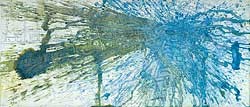Cosmic connections
New views of the universe by two
scientists-turned-artists
By Tony Ozuna
For The Prague Post
September 10th, 2008 issue
 COURTESY PHOTO
COURTESY PHOTO
|
| Gases
explode, atoms collide and galaxies swirl in the multimedia works of
painter/physicist Feldschuh.
|
| Jonathan Feldschuh and Tamsin van Essen:
Attraction/Repulsion
|
“Attraction/Repulsion” is an exhibition of two like-minded artists: American painter Jonathan Feldschuh and British sculptor Tamsin van Essen, both of whom studied physics at prestigious universities before embarking on more precarious careers as visual artists.
Feldschuh, born in 1964, has a degree from Harvard in physics. But his growing interest in art led him to Prague, where he studied painting at the Academy of Fine Arts from 1993 to 1996. He currently lives in New York City, exhibiting there as well as in Europe. This is his second show at Vernon Galerie, and it includes a few works that were shown in his 2003 Vernon debut.
Feldschuh’s older works are small canvases from 1998–2002, and they are remarkable. His earliest paintings, such as First Tracks (1998) and Fire Hazard (1998), are bright, densely painted liquid visions, with squirming, intestinal-shaped particles looming front and center. These abstract works were inspired by images seen from the Hubble Space Telescope and other orbiting observatories.
Other works from his earlier period, including Mini Nebula MI-67 (2002) and Mini Hurricane (2002), are standouts. These are macrocosmic fields, like landscapes from another planet, awash in fluids and bubbly gases and sealed in layers of clear acrylic. Mini Whirlpool Galaxy (2002) is a swirl of paint in dense layers, like a miniature vortex of colors, or gas and clouds, revealing their intricate forms in a flash and then disappearing.
His most recent works, from the series “Large Hadron Collider,” all attempt to fuse scientific imagery (with a touch of his own creative license) with abstract expressionist painting. The Large Hadron Collider, the world’s most powerful particle accelerator, is currently in operation near Geneva (at CERN), where scientists are investigating the fundamental laws of nature.
Feldschuh’s works are improvisations on the structure of the LHC, done on transparent mylar (like a thick wax paper), which gives the effect of multiple layers or three-dimensionality. LHC #13 is a collision of green waves with spheres hovering in the background; LHC #14 is an abstract image with the dense swirls and drips of his earlier works. Others include rough blueprints or details from space stations, depicting motion immersed in rays of color.
Tamsin van Essen also aims at physical re-creations of invisible or intangible worlds, including such phenomena as black holes, wormholes and structures from string theory. Her ceramic objects titled “Collection of Curious Objects” in the Vernon Project window gallery are an assortment of ceramic barbells held together by springs and funnels, solo or connected in pairs by chrome extensions.
Upstairs in the gallery, her works from the series “Medical Heirlooms” are more compelling. These vessels are based on 17th- and 18th-century apothecary jars, with deliberate defects and blemishes — some hideous to the touch — that create the symptoms of illnesses on the ceramic objects, which are billed as containers of disease. Above the vessels are old-fashioned posters explaining the particular affliction, such as syphilis, psoriasis, cancer, acne and osteoporosis. There are old medical-book definitions (from the 17th and 18th centuries) with color-illustrated examples, both historical and modern.
Some of van Essen’s fragile vessels are horribly deformed, while others seem to be deteriorating. But they are all aesthetically compelling in their fragility and craftsmanship, intentionally rebuking the historical association of certain illnesses and diseases with ugliness — something necessary to hide. This creates a different form of attraction. For van Essen, scars, flaws or deformities add a positive facet of individuality. And, in this way, repulsion is just another form of our attraction to the unknown, the incomprehensible — the dangerous.
Born in 1975, van Essen graduated from Oxford University with a joint degree in physics and philosophy, and also studied at Central Saint Martin’s College of Art and Design in London. She currently lives in Prague. This is her first exhibition at Vernon, though she has previously exhibited her works in London, Tokyo, Milan and Miami.
Through their art, both Feldschuh and van Essen are still pursuing the scientist’s quest to understand the physical universe. Instead of following this quest through mind-boggling mathematical equations and scientific theories, however, they create complex artworks. These are a true discovery, and not just on the Prague art scene.
|
Read all available reviews: |
|